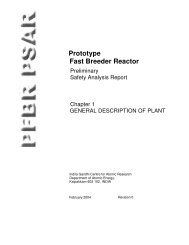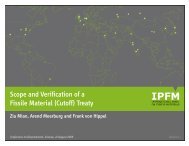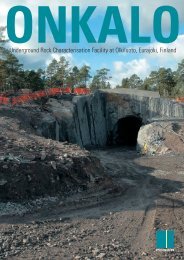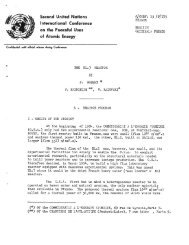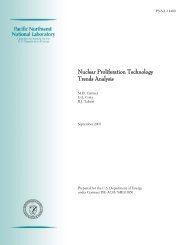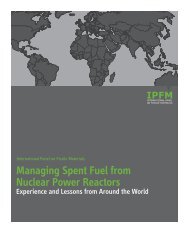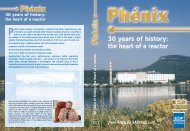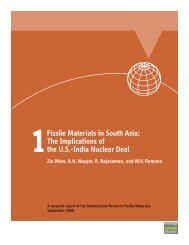Global Fissile Material Report 2009: A Path to Nuclear Disarmament
Global Fissile Material Report 2009: A Path to Nuclear Disarmament
Global Fissile Material Report 2009: A Path to Nuclear Disarmament
Create successful ePaper yourself
Turn your PDF publications into a flip-book with our unique Google optimized e-Paper software.
Verified warhead dismantlement. A critical verification challenge will be <strong>to</strong> ensurethat, once a state has declared its nuclear-weapon and component s<strong>to</strong>ckpiles, none oftheir contained fissile materials go astray before the fissile materials are converted <strong>to</strong>unclassified forms and placed under international moni<strong>to</strong>ring pending disposition.Chapter 5 reviews and builds on a 1990s U.S.-Russian “lab-<strong>to</strong>-lab” project that attempted<strong>to</strong> devise minimally intrusive approaches <strong>to</strong> verifying warhead dismantlement. Akey addition is the early selection by international inspec<strong>to</strong>rs at deployment and s<strong>to</strong>rageareas of a random sample of warheads and components of each declared type astemplates <strong>to</strong> provide radiation “fingerprints” for comparison with warheads and componentsdeclared later <strong>to</strong> be of the same types. This allows warheads <strong>to</strong> be identifiedwithout revealing detailed nuclear weapon design information. The chapter also findsthat the verification of nuclear-weapon dismantlement could be greatly simplified ifthe quantities and iso<strong>to</strong>pic compositions of the plu<strong>to</strong>nium and HEU in each type ofnuclear warhead were declassified.Disposition of HEU and plu<strong>to</strong>nium s<strong>to</strong>cks. <strong>Nuclear</strong> disarmament would release about900 <strong>to</strong>ns of HEU and 150 <strong>to</strong>ns of plu<strong>to</strong>nium currently in nuclear warheads and the associatedproduction complexes. If the United States, Russia and the United Kingdomwere <strong>to</strong> follow France’s example and convert their naval-propulsion reac<strong>to</strong>rs <strong>to</strong> low-enricheduranium fuel, an additional 200 <strong>to</strong>ns of HEU in naval reserves—enough <strong>to</strong> make8,000 nuclear weapons—could also be eliminated. Chapter 6 discusses the challengeof doing so.There is ample precedent for the disposition of HEU from weapons. In the 1990s Russiaand the U.S. <strong>to</strong>gether declared excess for military purposes about 700 <strong>to</strong>ns of HEU.Almost 500 <strong>to</strong>ns of this excess HEU, mostly Russian, has been down-blended <strong>to</strong> makelow-enriched uranium (LEU) <strong>to</strong> fuel nuclear power reac<strong>to</strong>rs and the rest will be. In contrast,none of the about 90 <strong>to</strong>ns of weapon-grade plu<strong>to</strong>nium declared excess by Russiaand the United States has yet been eliminated. Plans <strong>to</strong> use this plu<strong>to</strong>nium <strong>to</strong> fabricatemixed plu<strong>to</strong>nium-uranium oxide (MOX) for reac<strong>to</strong>r fuel have made little progress whilecosts have dramatically increased in both states. It is time <strong>to</strong> suspend this effort and<strong>to</strong> consider alternative disposition options that would cover both current and futureplu<strong>to</strong>nium declared excess. In the meantime, all excess HEU and weapons plu<strong>to</strong>niums<strong>to</strong>cks and associated disposition facilities should <strong>to</strong> be put under IAEA moni<strong>to</strong>ring.This would establish a basis for arrangements that could apply <strong>to</strong> other weapon stateswhen they declare fissile material excess and dispose of it.Two hundred and fifty <strong>to</strong>ns of separated civilian—but still weapon-usable—plu<strong>to</strong>niumalso have <strong>to</strong> be disposed of <strong>to</strong> make nuclear disarmament more irreversible. The UnitedKingdom, which owns about one third of this separated civilian plu<strong>to</strong>nium, has justbegun <strong>to</strong> discuss how <strong>to</strong> dispose of it. The United Kingdom should end efforts <strong>to</strong> getits troubled reprocessing plant back in<strong>to</strong> operation since success would only make itsplu<strong>to</strong>nium disposition problem larger.Verification of a ban on the production of fissile material for weapons. A verifiable<strong>Fissile</strong> <strong>Material</strong> Cu<strong>to</strong>ff Treaty (FMCT) that ends all production of fissile material forweapons would be an essential building block for a nuclear-disarmament regime and islikely <strong>to</strong> be the first international agreement along that path. A detailed discussion ofboth the scope and verification of a <strong>Fissile</strong> <strong>Material</strong> Cu<strong>to</strong>ff Treaty was the centerpieceof <strong>Global</strong> <strong>Fissile</strong> <strong>Material</strong> <strong>Report</strong> 2008, with the main ideas of that report summarizedhere in Chapter 7. <strong>Global</strong> <strong>Fissile</strong> <strong>Material</strong> <strong>Report</strong> <strong>2009</strong>



